From The Adventure Gamer
Written by Reiko
The last game I played through for the blog was Dune (let’s pretend Rome never happened), which was more or less based on the famous science fiction novel, and before that was Gateway. Up next, I have the opportunity to present another game based on a famous science fiction novel: Ringworld, by Larry Niven. I’m seeing a theme here.
 |
| Front cover of the original release. |
So there was some talent involved with this game, which shows in its colorful graphics and detailed character and setting designs. The graphic design actually reminds me somewhat of the 1994 strategy/adventure game Alien Legacy, but it’s possible that it’s just the level of the tools available at that time.
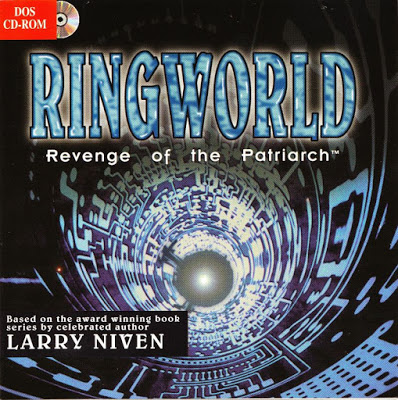 |
| Front cover of the CD-ROM release. |
Sometime in the next year, a CD-ROM version was released (the original was on floppies), but I haven’t found much information about the differences. The CD-ROM was supposed to contain several tracks of music, but the archive.org description indicates that the tracks didn’t seem to exist on the disk, or were written in a non-standard format.
As with the other games based on science fiction novels, adapting the setting and concept to a game format meant changing the plot and characters, often significantly, or taking a completely different perspective on the plot. I haven’t read much of the original novel, but some copies of the game shipped with the book, which seems to be implying that it might be a good idea to read it. Ringworld ties in with Niven’s “Known Space” setting, in which he wrote several other books and stories, so the setting is well-developed and complex. I read up on it in preparing for this game.
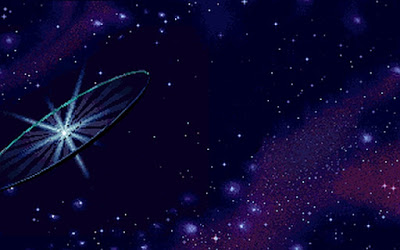 |
| Artist’s concept of the Ringworld |
At any rate, I was already familiar with the concept of a “ringworld,” since that has been carried over into other science fiction settings since then, including multiple 4X space games like Stellaris. A ringworld is a huge ring-shaped structure built along an entire orbit around a star. Instead of a planet orbiting around the star, the whole structure just rotates around it.
It’s a cool concept for an alien structure in theory, but in practice, it’s completely silly. I have no idea where you’d get enough physical material to even build that large of a framework, never mind all the organic material needed to make it habitable. Niven’s Ringworld was supposedly large enough to have the surface area of millions of Earths. Even Jupiter only has the mass of 318 Earths, and quite a lot of that is gaseous, so even if you (somehow??) spread it out relatively thinly into a flat ring structure, I’m not sure you’d have enough. But “aliens did it” and that’s all you need to know, apparently. It’s the science fiction equivalent of “wizards did it.”
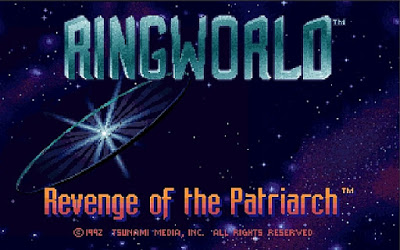 |
| Title screen |
After the title screen displays, we get the option to see the introduction or just start the game. The introduction starts with a credits listing, including an official credit to Larry Niven. Then we get a cutscene introducing the main conflict. So far, this game is rather plot-heavy, so I’ll do my best to summarize. Also, it feels like a sequel to an existing story, which doesn’t help. Actually, I noticed the back cover mentions Larry Niven himself saying that it’s a sequel to the first two books. So I guess we’re jumping into the middle of the story. Whee!
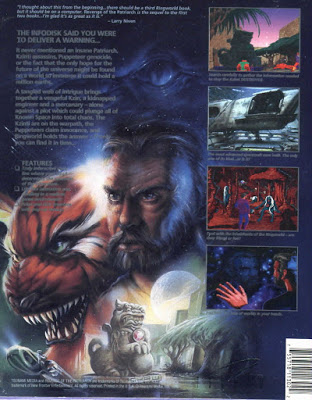 |
| Back cover of the box |
Let me start with the characters. The introductory cut-scene is between the Kzinti king, or Patriarch, and his trusted centurion Shachra. The Kzinti are a violent race of male-dominated felinoid aliens. Niven’s setting involves several wars between humans and Kzinti, although I don’t know exactly where in the timeline the game is set. I suspect it’s fairly late, because the first thing the Patriarch says is that he wants to destroy the Puppeteers for their audacity in using the Kzinti in a breeding experiment. Hence, “Revenge of the Patriarch.”
The Puppeteers are a very strange race which I’ll describe more later if they show up on screen, but they’re highly technologically advanced, very focused on the safety and preservation of themselves and their race, and like to meddle in other races’ social and genetic development. So the Kzinti want to destroy them because the Puppeteers deliberately instigated the wars between humans and Kzinti in order to kill off the more aggressive side of Kzinti society. (The experiment didn’t extend as far as the Patriarch yet, I guess.)
 |
| The throne room decorations look rather Aztec to me, appropriate for an aggressive race. |
In the Ringworld novel, the main characters are Louis Wu and the Kzinti Speaker-to-Animals, also called Chmeee, who end up on a mission to Ringworld at the request of the Puppeteers. But the game starts off with Louis Wu’s mercenary friend Quinn and Chmeee’s son Iacch-Captain, who must find out what happened to Louis Wu and Chmeee after they mysteriously disappeared. The Patriarch mentions Louis Wu and “the traitor Chmeee” as having acquired a new and improved hyperdrive (which in the novel is a reward from the Puppeteers for escaping Ringworld), which the human government immediately used to construct a fancy new exploration vessel. I assume Chmeee is considered a traitor by the Patriarch for working together with a human.
So the Kzinti (at least the Patriarch’s faction) want to destroy the Puppeteers and strike a blow at humans as well. Somehow they’ve managed to duplicate the human exploration vessel. The Patriarch expects his centurion to captain this duplicate and accomplish three tasks: kill everyone at the Chmeee family home, find and destroy the entire Puppeteer homeworld, and take over the human ship. I had to wonder very briefly if we were supposed to be controlling this centurion, but no, I’m sure we’ll have to thwart these plans, so it’s important that the player knows about them.
I should mention that the backstory of the human-Kzinti wars isn’t all explained in this introduction. If you’re familiar with the setting, you’ll likely know it, but if not, I think it would be rather confusing being dumped into the middle of this conflict. It’s not very clear to me, either, especially when it comes to what Louis Wu and Chmeee have already done before the game even started.
 |
| Quinn’s motivation for being here |
Gameplay begins at the Chmeee family home with Louis Wu’s mercenary friend Quinn, who is over 200 years old, thanks to something called “boosterspice” (presumably no connection to Dune’s spice), which halts aging for a period of years. Louis Wu was 200 at the beginning of the original Ringworld novel, too. Quinn muses briefly about how Louis Wu is the only one who would have the foresight to send a “just in case I disappear” message before he actually disappears. Convenient, that. So Louis Wu has disappeared and Quinn has to track him down.
Now I have to pause for a minute to show the interface. It’s more or less a tidy reskin of the familiar Sierra interface, with a few subtle differences that make it slightly more awkward to use. The right-click button will bring up the menu in a compact triangular-ish design right on screen, rather than in a menu bar at the top. The top button is the look action; the next two are move/walk and use/touch. Bottom left is talk, bottom middle is inventory, and bottom right brings up the utility menu, including save and quit.
 |
| Interface with initial inventory |
It’s all pretty standard for adventure games of this era, really. Very intuitive. Except that, with the exception of look (and move), the other actions (touch, talk, and using an inventory item) all shift back to the default move cursor after you click on something. That means that, as far as I can tell, you can’t try using multiple things on-screen in a row without going through the menu every time. And you can’t try using an inventory item in multiple places without bringing up the item again every time.
In Sierra games, the cursor would stay on a particular mode until you shifted it with the right mouse button or clicked on a menu item. Here, the right mouse button shows you the whole menu. And the clicks aren’t as responsive as I might like. Sometimes the right-click doesn’t work right away, and sometimes I right-click and end up with the wrong menu option selected.
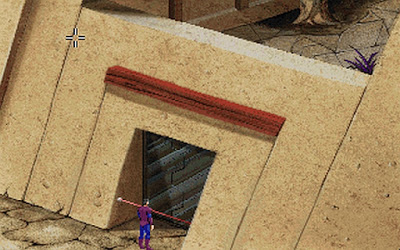 |
| The entrance to the Chmeee family home |
I mention these interface difficulties because I’m a little worried that there might be a bit of pixel-hunting. The first gameplay screen shows Quinn outside the front doorway of the Chmeee family home. The door is blocked with a laser doorbell system. The laser is only a couple of pixel-widths high. It took me an embarrassingly long time to determine that to proceed, all I had to do was touch the laser to block it, which basically rang the doorbell and alerted the family that they had a visitor.
Quinn’s inventory starts out with three items: a stunner weapon, some kind of scanner, and a signet ring from Louis Wu. I spent far too long trying to scan that laser before I figured out how to trigger it.
I’ll pause here, with Quinn having gotten the attention of the Kzinti in the home. Next time, the plot will thicken and we’ll have to make a run for it.
Ringworld can be played from archive.org or downloaded and played through DOSBox if you’d like to play along with me.
Note Regarding Spoilers and Companion Assist Points: There’s a set of rules regarding spoilers and companion assist points. Please read it here before making any comments that could be considered a spoiler in any way. The short of it is that no CAPs will be given for hints or spoilers given in advance of me requiring one. As this is an introduction post, it’s an opportunity for readers to bet 10 CAPs (only if they already have them) that I won’t be able to solve a puzzle without putting in an official Request for Assistance: remember to use ROT13 for betting. If you get it right, you will be rewarded with X CAPs in return. It’s also your chance to predict what the final rating will be for the game. Voters can predict whatever score they want, regardless of whether someone else has already chosen it. All correct (or nearest) votes will go into a draw.
Original URL: https://advgamer.blogspot.com/2019/08/game-111-ringworld-revenge-of-patriarch.html
